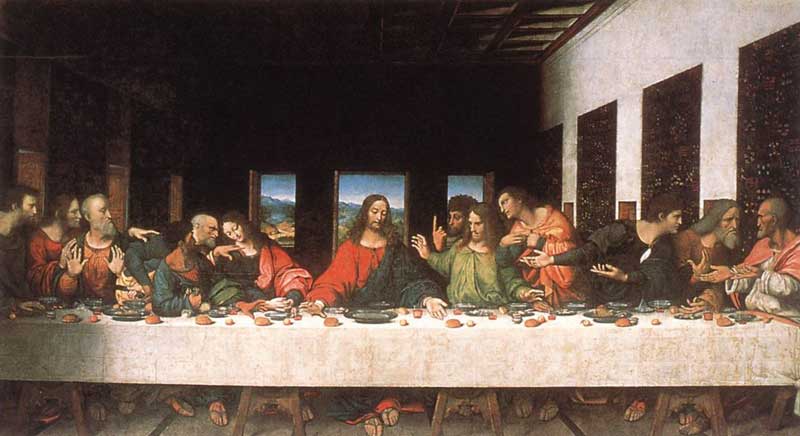
Located on the wall of the dining room of the former Dominican convent of Santa Maria delle Grazie in Milan, exactly in the refectory of the convent, the Last Supper, a late 15th-century mural painting by the great Italian artist Leonardo da Vinci, is one of the most famous and fascinating, most studied and reproduced and the subject of many legends and controversies. Commissioned by Ludovico Sforza, the Duke of Milan and painted by the master artist between 1495 and 1498, the coloured plaster of the enormous fresco measuring 15 by 29 feet (4.6 x 8.8 meters), covers the entire wall of the refectory, although the room was not a refectory at the time that Leonardo painted it.
Instead of using tempera on wet plaster, the usual method of fresco painting, Leonardo painted it on dry plaster, as he sought a greater detail and luminosity than could be achieved with traditional fresco and it resulted in a more varied palette. In fact, traces of gold and silver foils have been found which testify to the artist's eagerness to make the figures much more realistic. He chose to seal the stone wall with a double layer of dried plaster, composed of gesso (gypsum prepared with glue), pitch, and mastic. After that, he added an undercoat of white lead to enhance the brightness of the oil and tempera that was applied on top. Unfortunately, his experiment did not work, as the painted plaster began to flake off the wall almost immediately. Various authorities have struggled to restore it ever since.
The layout of the fresco is largely horizontal. All the figures are set behind the large table, which is seen in the foreground of the image. The painting is also largely symmetrical with the same number of figures on either side of Jesus.

The Last Supper is the visual interpretation of the artist of an event chronicled in all four of the Gospels, depicting the evening before Christ was to be betrayed by one of his disciples. He gathered them all together to eat and to tell them that he knew what was going to happen soon. The fresco depicts the next few seconds in this story after Christ dropped the bombshell that one of his disciples would betray him before the sunrise and the different reactions of horror, shock and anger of the twelve apostles. In Leonardo da Vinci’s interpretation, the moment represents the moment before the birth of the Eucharist, with Jesus reaching for the bread and a glass of wine that would be the key symbols of the Christian sacrament.

In recent years, much of the interest in the painting has centered on the details hidden within the painting. Many scholars have discussed about the hidden meaning of the spilled salt container near an elbow of Judas. The spilled salt has been said to represent his betrayal or could symbolize bad luck, loss, religion or Jesus as the salt of the earth. It is also claimed by some biblical scholars that the disciple, painted at the right hand of Jesus, is John. However, many art and biblical scholars believe that actually the person is a woman, since he/she is the only person in the picture wearing a necklace or a charm, which is not a small one and in all probability, she is Mary Magdalene.
It is quite evident from the painting that, many of the figures on the right side of the table seem to be talking to or at Mary, while Jesus appears to be engaged with those on the left, who reflect the concern the disciples must have felt when told one among them would betray Christ. A closer look will at ‘John’ will also reveal a resemblance to Mona Lisa, which the master artist painted five years later.

Unfortunately, in the ensuing centuries, the Last Supper had been a victim of abuse for several times. In 1652, a new door was cut in the wall of the deteriorating painting, which removed a chunk of the artwork showing the feet of Jesus. The painting endured additional irreverence in the late 18th century, when the invading troops of Napoleon Bonaparte used the refectory as a stable and further damaged the wall with projectiles.
During World War II, the roof and one wall of the refectory collapsed due to the bombing of the Allied forces. Though the painting survived, it was exposed to the elements for several months before the space was rebuilt.

The Last Supper was subject to numerous restoration attempts and it underwent an extensive and controversial 20-year restoration that was completed in 1999. However, many critics argued that the restorers had removed so much of the painting that very little was left of Leonardo’s original work.